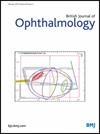Prevalence and risk factors of myopic macular degeneration: the Aier-SERI high myopia adult cohort
IF 3.7
2区 医学
Q1 OPHTHALMOLOGY
引用次数: 0
Abstract
Purpose To assess the prevalence and risk factors of myopic macular degeneration (MMD) in young and middle-aged individuals with high myopia in Changsha, central China. Methods A total of 445 adults with high myopia (worse than or equal to −5.0 D) were examined between 2021 and 2023. Autorefraction and biometry using IOLMaster were conducted, and fundus photos were graded for MMD using Meta-PM criteria. MMD was diagnosed if category 2, 3, 4 or any plus lesion was present. Risk factors such as age, gender, spherical equivalent (SE)/axial length (AL), body mass index, education and residence were analysed via logistic regression. Results Participants had an average age of 42.3±7.3 years. MMD prevalence was 21.8% (71 adults) with a mean SE of −9.5±4.7 D and AL of 27.3±1.9 mm. Significant risk factors included greater myopic SE (OR=1.7 per 1 D decrease) and longer AL (OR=3.6 per 1 mm increase). MMD prevalence rose sharply with myopia worse than −10.00 D and AL >27.00 mm, reaching up to 100% for myopia worse than −14.00 D or AL ≥29.00 mm. Conclusion MMD affects about one in five young to middle-aged adults with high myopia. Those exceeding critical myopia and AL thresholds are at higher risk and should be closely monitored. Further research on interventions to prevent axial elongation is needed, particularly for those with high genetic risk. Data are available upon reasonable request.近视黄斑变性的患病率及危险因素:Aier-SERI高度近视成人队列
目的了解长沙市中青年高度近视人群的近视性黄斑变性(MMD)患病率及其危险因素。方法对2021 ~ 2023年445例成人高度近视(≤- 5.0 D)患者进行检查。使用IOLMaster进行自折射和生物测定,并使用Meta-PM标准对眼底照片进行MMD分级。如果出现2、3、4类或任何附加病变,则诊断为烟雾病。通过logistic回归分析年龄、性别、球形当量(SE)/轴长(AL)、体重指数、文化程度和居住地等危险因素。结果患者平均年龄42.3±7.3岁。烟雾病患病率为21.8%(71名成人),平均SE为- 9.5±4.7 D, AL为27.3±1.9 mm。显著的危险因素包括更大的近视SE (OR=1.7每1 D减少)和更长的AL (OR=3.6每1 mm增加)。当近视≥- 10.00 D和AL≥27.00 mm时,烟雾患病率急剧上升,当近视≥- 14.00 D或AL≥29.00 mm时,烟雾患病率高达100%。结论青壮年至中年高度近视患者中约有1 / 5受烟雾病影响。那些超过严重近视和AL阈值的人有更高的风险,应密切监测。需要进一步研究预防轴向伸长的干预措施,特别是对那些具有高遗传风险的人。如有合理要求,可提供资料。
本文章由计算机程序翻译,如有差异,请以英文原文为准。
求助全文
约1分钟内获得全文
求助全文
来源期刊
CiteScore
10.30
自引率
2.40%
发文量
213
审稿时长
3-6 weeks
期刊介绍:
The British Journal of Ophthalmology (BJO) is an international peer-reviewed journal for ophthalmologists and visual science specialists. BJO publishes clinical investigations, clinical observations, and clinically relevant laboratory investigations related to ophthalmology. It also provides major reviews and also publishes manuscripts covering regional issues in a global context.

 求助内容:
求助内容: 应助结果提醒方式:
应助结果提醒方式:


